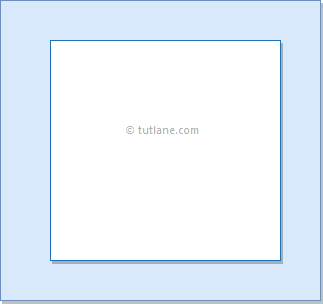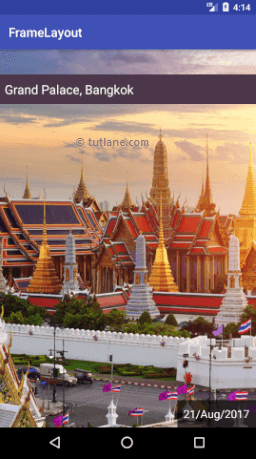In android, Framelayout is a ViewGroup subclass that is used to specify the position of View instances it contains on the top of each other to display only single View inside the FrameLayout.
In simple manner, we can say FrameLayout is designed to block out an area on the screen to display a single item.
Following is the pictorial representation of frame layout in android applications.

In android, FrameLayout will act as a placeholder on the screen and it is used to hold a single child view.
In FrameLayout, the child views are added in a stack and the most recently added child will show on the top. We can add multiple children views to FrameLayout and control their position by using gravity attributes in FrameLayout.
Following is the example of creating a FrameLayout with different controls in android application.
Create a new android application using android studio and give names as FrameLayout. In case if you are not aware of creating an app in android studio check this article Android Hello World App.
Now open an activity_main.xml file from \res\layout path and write the code like as shown below
<?xml version="1.0" encoding="utf-8"?>
<FrameLayout xmlns:android="http://schemas.android.com/apk/res/android"
android:layout_width="match_parent"
android:layout_height="match_parent"
android:orientation="vertical">
<ImageView
android:id="@+id/imgvw1"
android:layout_width="wrap_content"
android:layout_height="wrap_content"
android:scaleType="centerCrop"
android:src="@drawable/flimg" />
<TextView
android:id="@+id/txtvw1"
android:layout_width="match_parent"
android:layout_height="wrap_content"
android:layout_marginTop="40dp"
android:background="#4C374A"
android:padding="10dp"
android:text="Grand Palace, Bangkok"
android:textColor="#FFFFFF"
android:textSize="20sp" />
<TextView
android:id="@+id/txtvw2"
android:layout_width="wrap_content"
android:layout_height="wrap_content"
android:layout_gravity="right|bottom"
android:background="#AA000000"
android:padding="10dp"
android:text="21/Aug/2017"
android:textColor="#FFFFFF"
android:textSize="18sp" />
</FrameLayout>
If you observe above code we used ImageView to show the image (flimg) from drawable folder in framelayout. So add your image to drawable folder and replace @drawable/flimg path with your image path.
Once we are done with the creation of layout, we need to load the XML layout resource from our activity onCreate() callback method, for that open main activity file MainActivity.java from \java\com.tutlane.framelayout path and write the code like as shown below.
package com.tutlane.linearlayout;
import android.support.v7.app.AppCompatActivity;
import android.os.Bundle;
public class MainActivity extends AppCompatActivity {
@Override
protected void onCreate(Bundle savedInstanceState) {
super.onCreate(savedInstanceState);
setContentView(R.layout.activity_main);
}
}
If you observe above code, we are calling our layout using setContentView method in the form of R.layout.layout_file_name. Here our xml file name is activity_main.xml so we used file name activity_main.
Generally, during the launch of our activity, the onCreate() callback method will be called by the android framework to get the required layout for an activity.
When we run the above example using the android virtual device (AVD) we will get a result like as shown below.

This is how we can use frame layout in android applications based on our requirements.